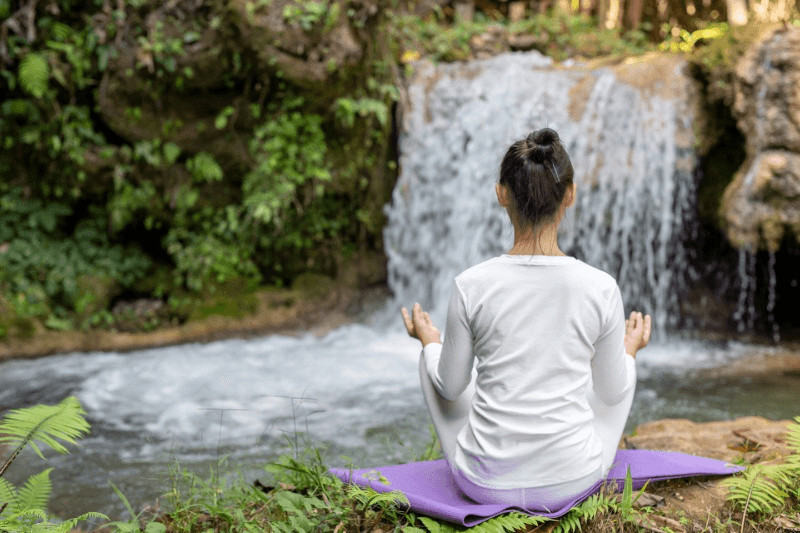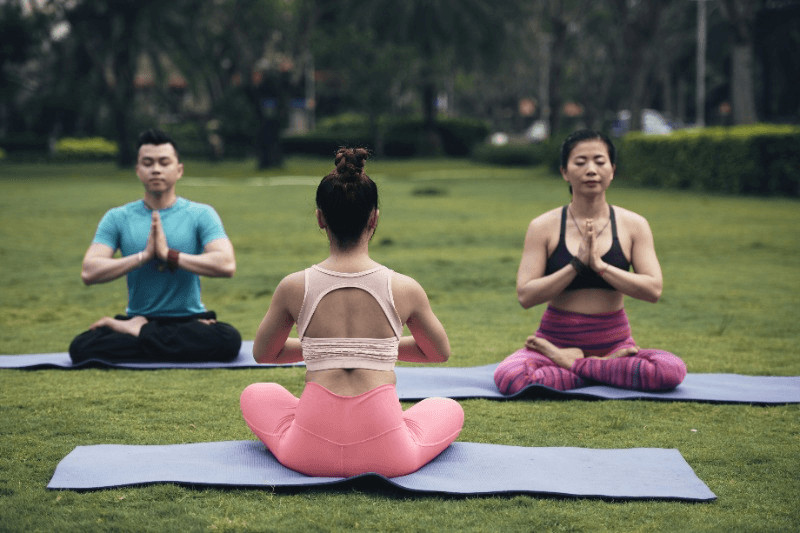Listen to this article:
Key Takeaway
Embarking on the journey of Samyama meditation unveils a profound opportunity to deepen one’s yoga practice, fostering inner growth, self-understanding, and a transformative connection to the essence of existence.
Samyama caught my eye as a profound concept rooted in ancient yogic traditions, blending concentration, meditation, and absorption into a singular practice.
It’s like unlocking the ultimate level of mindfulness, where every moment is rich with insight and tranquility. Diving into Samyama has shown me a path to a deeper understanding of myself and the world around me.
This journey isn’t just about mastering techniques; it’s about embracing a philosophy that dates back thousands of years, offering wisdom that seems more relevant today than ever.
Contents
- 1 Understanding Samyama in Yoga Practice
- 2 Prerequisites for Samyama Practice
- 3 Exploring the Meaning and Framework of Samyama
- 4 Internal Samyama and Its Impact on Yoga
- 5 Transforming Your Yoga Practice through Samyama
- 6 The Spiritual Effects of Samyama in Yoga
- 7 How to Practice Samyama for Yoga Transformation
- 8 Connecting with Samyama: Meditation and Retreats
- 9 Closing Thoughts
- 10 Frequently Asked Questions
- 10.1 What is Samyama in yoga practice?
- 10.2 Are there any prerequisites for practicing Samyama?
- 10.3 How does Samyama transform my yoga practice?
- 10.4 Can anyone achieve the spiritual effects of Samyama in Yoga?
- 10.5 What steps should I take to start practicing Samyama?
- 10.6 How do meditation retreats help with connecting to Samyama?
- 10.7 Was this helpful?
Understanding Samyama in Yoga Practice
Yoga Roots
Samyama is a profound concept in yoga. It comes from ancient texts. These texts talk about how to reach inner peace and understanding.
I find it fascinating that samyama isn’t just one action but a combination of three stages. This makes it unique compared to other yoga practices I’ve tried, like asanas or pranayamas. Those focus more on physical or breathing exercises.
Stages Explained
Dharana, Dhyana, and Samadhi are the stages of Samyama. Every step builds on the one before it.
- Dharana means concentration.
- Dhyana refers to meditation.
- Samadhi is about achieving unity with the object of meditation.
Together, these stages help practitioners go deeper into their consciousness than regular meditation.
Consciousness Shift
You can reach higher levels of awareness by engaging in samyama practice. Although challenging, the payoff is great when it is accomplished.
In my experience, using samyama to achieve these higher realms has changed my life. It’s like seeing the world with new eyes; everything seems clearer and more meaningful.
Prerequisites for Samyama Practice
Basic Skills
Mastering basic yoga asanas and meditation techniques is crucial. Before diving into samyama, one should be comfortable with simpler forms of yoga. This includes knowing how to control your breathing and being able to hold poses for longer periods.
I discovered that beginning with simpler poses enabled me to develop the flexibility and strength required for increasingly difficult ones. It’s similar to learning to walk before running.
Disciplined Lifestyle
A disciplined lifestyle significantly impacts your practice success. This includes maintaining a balanced diet, getting enough sleep, and abstaining from bad habits like smoking and binge drinking.
Establishing a rigorous schedule was satisfying but challenging for me. I noticed improvements in my focus and overall well-being, which were essential for advancing my samyama practice.
Expert Guidance
Learning under an experienced teacher is highly recommended. They can offer personalized advice and correct mistakes you might not notice on your own. Finding a mentor who understood my goals made all the difference. They pushed me beyond what I thought was possible while ensuring I stayed safe during practice, guiding me towards mastery of the ancient techniques of Samyama.
Exploring the Meaning and Framework of Samyama
Sanskrit Breakdown
Samyama is a compound Sanskrit term that unites three critical stages: Dharana, Dhyana, and Samadhi. These stages represent concentration, meditation, and absorption, respectively. Together, they form a pathway to achieving total awareness.
In my experience with samyama, understanding these components was crucial. Dharana taught me how to focus on a single object or idea. This focus deepened into Dhyana, where I experienced uninterrupted flow in meditation.
Finally, Samadhi brought an overwhelming sense of unity to the object of my meditation.
Sequential Practice
The practice of samyama unfolds sequentially. Each step must be mastered before going on to the next. It’s like trying to climb a ladder—you must use every step to reach the top safely.
- First comes Dharana.
- Then, it progresses into Dhyana.
- And culminates in Samadhi.
This structure emphasizes gradual growth and understanding. Recognizing this sequence helped set realistic expectations for my progress in spiritual practices.
Theoretical Foundation
Samyama rests on solid theoretical foundations in ancient texts like Patanjali’s Yoga Sutras. Here, it’s described as a tool for reaching deeper states of consciousness through focused attention on nature’s reality or self-love discrimination possibilities.
The Scriptures outline samyama as comprising eight limbs or stages that guide practitioners from moral codes to achieving liberation or realization of one’s true nature without losing sight of love and discrimination among objects partaking in reality.
Internal Samyama and Its Impact on Yoga
Focused Observation
Practicing samyama involves deep internal observation. This entails being acutely aware of our sensations, feelings, and thoughts while maintaining an open mind. It’s similar to observing a river run by, taking in each ripple without being carried away.
This technique has been effective for me in raising my level of self-awareness. I’ve been able to recognize patterns in my thoughts and feelings that I was previously unaware of by paying so close attention to my inner world. For me, this has changed the game.
Mental Clarity
Samyama can lead to remarkable mental clarity and emotional stability. We start seeing things more clearly when we observe our minds without attachment. Our minds become less overloaded with pointless ideas, which frequently lead to anxiety and perplexity.
Thanks to this improved mental clarity, I’ve been able to make better judgments in both my personal and professional lives. It’s like organizing a closet; suddenly, you have more room to move around and breathe.
Deepening Meditation
Finally, samyama contributes significantly to deepening meditation experiences. With the distractions of the mind reduced through focused observation, meditation becomes more profound.
Benefits include:
- Enhanced concentration
- Greater peace
- Deeper spiritual insights
Through incorporating samyama into my yoga practice, I have personally experienced these advantages. My meditation sessions have evolved from simple periods of silence to profound explorations of the mind.
Transforming Your Yoga Practice through Samyama

Daily Integration
Integrating Samyama into your daily yoga routine can shift your practice from merely physical to deeply spiritual. It starts with the integration of Yama, concentration, and meditation into every movement. This process turns each pose into a tool for deeper awareness.
Starting my day with a focus on breath and intention set the tone for my entire practice. By concentrating on the absorption in each posture and maintaining complete silence, I began to experience lightness in both body and mind.
This wasn’t an overnight transformation but a gradual evolution where each session was built upon the last.
Profound States
Samyama leads you beyond physical postures into profound meditative states. The journey from mastering basic techniques to experiencing explosive states of consciousness is unique for everyone.
It was like unlocking a new level of understanding within myself.
- Mastery of body and mind.
- Power of absorption.
- Lightness and clarity.
These are not just goals but milestones in the transformative path that Samyama offers. Through consistent practice, I reached points where time seemed to stand still, and my sense of self expanded beyond the confines of my mat.
The Spiritual Effects of Samyama in Yoga
Spiritual Growth
Practicing Samyama can accelerate spiritual growth significantly. This technique helps yogis understand their inner selves better and love themselves, fostering a deeper connection to their true essence and purpose. It’s like unlocking a door to deeper knowledge.
By introducing samyama into my routine, I’ve discovered that my relationship with myself has become more intimate. Every session seems like it’s peeling back the layers to reveal more about me and my purpose.
Samyama also urges us to face our karma squarely. This confrontation speeds up our spiritual journey by helping us resolve past issues.
Universal Unity
Another profound effect of samyama is the experience of unity with the universal consciousness. Yogis claim a sense of oneness with everyone, everything, and the natural world.
It’s difficult to describe, but this feeling of oneness is similar to realizing that you are a drop in an endless ocean. My own experiences have given me a deep sense of serenity and belonging, which reassures me that we are all a part of something much bigger than ourselves.
Practitioners frequently gain self-realization and insights into reality due to such experiences. They begin to see life through a clearer lens.
How to Practice Samyama for Yoga Transformation
Step-by-Step Guide
Practicing samyama starts with focusing your mind. You begin by picking an object or idea to concentrate on. This could be a candle flame, a sound, or even your breath.
Next, you move into meditation. Here, you stop thinking about everything else and concentrate just on the item of your choice. It’s common for the mind to wander initially. Gently bring it back each time.
I’ve discovered that making time for it every day helps me be consistent. I function best in the early mornings when everything is still peaceful.
Consistency and Patience
Consistency is vital in samyama practice. Make an effort to meditate daily at the same time.
Patience is equally important. Though progress may appear sluggish at times, keep in mind that every step is significant.
I’ve found that documenting my meditation journey in a notebook has been beneficial for monitoring my development and maintaining motivation.
Overcoming Challenges
The early stages can be tough due to distractions and restlessness.
- Focus on breathing
- Use guided meditations
- Create a dedicated space for practice
These tips helped me overcome many initial hurdles in my practice of samyama.
Connecting with Samyama: Meditation and Retreats

Finding Retreats
Finding the right retreat for Samyama is key. These retreats offer an immersive experience in advanced yoga practices. They often last several days, giving you time to dive deep into your practice.
I remember my first retreat focused on Samyama. It was a residential program that lasted ten days. The complete silence and focus required were challenging but transformative.
Those ten days were super valuable for me, as they provided an immersive environment where I could deepen my practice and truly absorb the teachings of Samyama.
Retreats provide structured programs and knowledgeable instructors to guide participants through their journey. They cover meditation techniques, attention training, and insights into consciousness.
Community Support
The role of community support cannot be overstated. Practicing with others creates a shared energy that enhances the experience for everyone involved.
I found it easier to stay motivated and focused on my goals in these settings. Sharing experiences with fellow meditators gave me different perspectives on the subtler realms of awareness.
Community support also offers an opportunity for feedback from more experienced practitioners. This can lead to deeper insight and understanding of one’s mind and meditativeness.
Complementary Techniques
Meditation techniques that complement Samyama include focusing on breath or a mantra, visualization exercises, and mindfulness practices. This helps prepare the mind for the deeper levels of concentration necessary for advanced yoga practices like Samyama.
Practicing mindfulness daily has helped me significantly improve my focus during meditation sessions.
These complementary techniques foster increased peace, awareness, and insight into our inner workings—essential components for mastering Samyama.
Closing Thoughts
Diving into samyama transformed my yoga journey, making it more than just poses; it’s now a deep spiritual practice. Understanding its layers, from the prerequisites to profound spiritual effects, showed me yoga’s true power.
It’s not just about flexibility or strength; it’s about connecting deeply with myself and the universe. Practicing samyama opened doors to a transformative experience, proving that yoga is indeed a holistic path to enlightenment.
So, here’s my nudge to you: don’t just stop at asanas. Explore samyama. Let it strengthen your bond with the world and yourself, whether it be through daily practice, meditation, or retreats. I promise it will completely transform your spiritual journey. Ready to dive deeper? Your yoga mat awaits.

lululemon’s The Mat 5mm
Made With FSC™ Certified Rubber
Pop quiz! 🧘🤔
Practicing samyama can accelerate spiritual growth significantly
Samyama contributes significantly to deepening meditation experiences
Samyama unites three critical stages: Pratyahara, Dharana, and Dhyana
Frequently Asked Questions
What is Samyama in yoga practice?
Samyama is like unlocking a new level in your yoga journey. It’s an advanced technique that combines concentration, meditation, and absorption to deepen your understanding of yourself and the universe.
Are there any prerequisites for practicing Samyama?
Absolutely! Think of it as needing to know how to jog before you can sprint. Basics like focused attention (Dharana) and meditation (Dhyana) are must-haves under your belt before diving into Samyama.
How does Samyama transform my yoga practice?
Imagine turning up the volume on your favorite song; that’s what Samyama does for yoga. It enhances awareness and connection, making every pose more profound and impactful.
Can anyone achieve the spiritual effects of Samyama in Yoga?
Yes, but patience is key! Like planting a seed and waiting for it to sprout, achieving spiritual heights through Samyama takes time, dedication, and consistent practice.
What steps should I take to start practicing Samyama?
Start small; master basic meditation and breathing techniques first. As you get more comfortable, gradually introduce elements of concentration (Dharana) into your routine before fully stepping into Samyama practices.
How do meditation retreats help with connecting to Samyama?
Think of retreats as immersive boot camps for your soul. They provide dedicated time away from daily distractions, allowing deeper exploration into meditative states akin to those achieved through Samyama.







